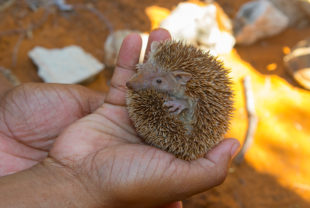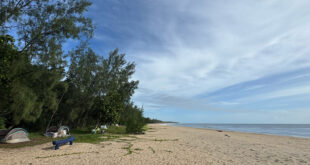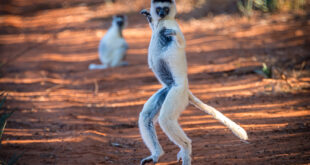In the southwest and deep south of Madagascar, you can encounter it: The Lesser Hedgehog Tenrec (Echinops telfairi). It lives in dry and spiny forests as well as savannahs, but also occurs in areas populated and destroyed by humans. Larger populations are however above all in forests, that obviously offer bigger protection from food-enemies. The northern distribution limit is the river Tsiribinha, the eastern one is the national park Andohahela.
Externally, the Lesser Hedgehog Tenrec with its thorn-dress actually resembles a hedgehog, however, the two species are not related. A Lesser Hedgehog Tenrec weighs only as much as an apple or a pear. The spiny coat is very different in color, it can range from light beige to dark brown. The Lesser Hedgehog Tenrec is a good climber. Its strong claws even enable it to climb down tree trunks headfirst. Accordingly, it is much on the way in shrubs and trees. By means of echolocation, the Lesser Hedgehog Tenrec orientates itself. It gives quiet clicking sounds on that occasion. Throughout the day, the Lesser Hedgehog Tenrec sleeps high up in knotholes and hollow trees in a nest. During the day, the animals can also be found sleeping in fallen tree trunks or piles of deadwood on the ground, more rarely in self-dug caves in the sand. The awake phase of the Lesser Hedgehog Tenrecbegins late in the afternoon. Only when it is dark does it become really active.

On the menu are mainly insects. If a small frog, a young mouse, or a juicy spider gets in its way, it doesn’t say no either. Lesser Hedgehog Tenrecs hardly need to drink, they get almost all their water from the food. This is an adaptation to life in the dry south of Madagascar, where water is scarce most of the year. In addition, Lesser Hedgehog Tenrecs can concentrate their urine strongly and thus save even more water.
The active season for the Lesser Hedgehog Tenrec is the rainy season. During the rainy season, the tenrecs reproduce, raise young and eat a layer of bacon for the meager time of the year. The Lesser Hedgehog Tenrec is basically a loner. Females and males meet only for mating. Before the mating, an hours lasting, noise-intensive dance-ritual stands. The male pushes the female with head-pushes around, the partners sniff themselves and rub their bodies together. After the combination, everyone goes its ways again.
The pregnancy of the female lasts approximately two months. The female prepares a nest for the offspring with plant-materials. She bears up to ten young. The Lesser Hedgehog Tenrecs come blind and naked to the world. The mother-animal has altogether twelve teats to let her young drink. Since the rainy season in Madagascar’s south lasts only a few months, sometimes even only weeks, the young become extremely fast independent. Already after four days, the thorn-dress is fully developed. With only ten days, the young undertake first trips until the entrance of the nest-cave. At the age of three to four weeks, the weaning already takes place. Despite the fast development, Lesser Hedgehog Tenrec need a whole dry season until they become sexually mature. If the days slowly become cooler in April and the nights really cold, the Lesser Hedgehog Tenrecsfall into a so-called cold rigidity (torpor). In this torpor, they wake up only briefly to feed and spend most of the time resting. During torpor, also their body temperature sinks extremely. The torpor is a further adaptation to the meager living conditions of the south.
In the reserves Reniala in Ifaty, Antsokay near Toliara and Kirindy, you can find Lesser Hedgehog Tenrecs with some luck in the rainy season, especially during night hikes. During the day you have to look for something to track down the small animals.
 MADAMAGAZINE Your Magazine about Madagascar
MADAMAGAZINE Your Magazine about Madagascar




